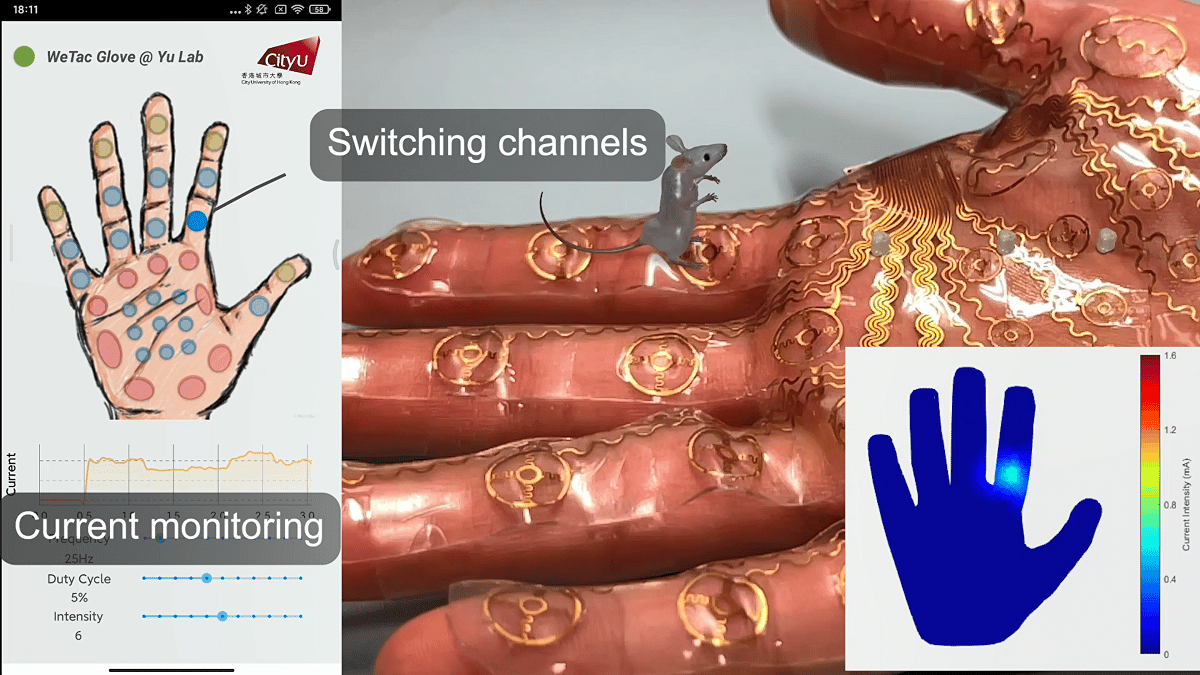
“Second look” to feel things in virtual reality
‘Feeling’ things in a virtual world… It’s a fantasy that’s been around for a long time, and it’s already fueled quite a bit of research. This time, a team of researchers from Hong Kong has developed a real “second skin” that can allow a high-quality personal touch experience in the world of virtual reality.
“ Improving the virtual experience with the sense of touch has become a hot topic, but today’s tactile devices usually remain bulky and tangled in wired systems. explains the City University of Hong Kong, V.I Press release detailing the project. Developed by a team of dedicated researchers, the new device aims to overcome these inconveniences. Called a WeTac, it looks like a “patch” to be applied directly to the skin, to reduce the sensation of bulkiness. The idea is to have a “second skin” that transmits sensations directly into the user’s body, by means of a weak electrical current. The team’s work has been published in Nature’s machine intelligence.
Obviously, this technology could find use in virtual reality video games, but not only. Researchers are also considering applications in remote social activities, training modules, or even automated remote control. ” Haptic feedback has great potential, along with auditory and visual feedback, in VR. Therefore, we tried to make the touch interface thinner, softer, more compact and wireless, so that it can be used freely in the hand, like a second skin. says Yu Xinge, an associate professor in the Department of Biomedical Engineering (BME) at CityU, who led the research, about the project.

The wireless device consists of two parts. A flexible and small controller is attached to the forearm. The hydrogel-based patch, lined with electrodes, constitutes the second major component. This acts as a haptic interface and is applied to the skin: the hand, for the time being. The driver unit weighs just over 19g and measures 5cm x 5cm, with a thickness of 2mm. The patch has a thickness of 1 mm and is very flexible to be able to follow the movements of the hand.
personal touch
The peculiarity of this technology is also that it seeks to personalize the touch according to the user. ” Electrical stimulation is a good way to provide effective virtual touch to users Yu Xing explains. ” However, since individuals have different sensitivities, the same strength of feedback may be felt differently in the hands of different users. In other words, no one wants to feel like they are being electrocuted to feel something.” So we need to customize feedback settings accordingly to provide a universal tool for all users and eliminate another major bottleneck of current haptic technology. So defines the world.

According to the researchers, the device’s flexibility makes it easy to set “threshold currents” for users. In other words, it is possible to adjust the patch to obtain a range of intensity of sensation to which it corresponds. This will help avoid causing pain or having an outcome that is too weak to feel. For added sensitivity, the researchers distributed 32 “stimulation pixels”. The distance between the two electrodes is only 13 mm, which makes it possible to distinguish the sensations even on a palm scale.
and to worry, The device has several built-in safety measures to protect users from electric shock, and the temperature of the device is kept in a relatively low range of 27-35.5°C to avoid causing thermal discomfort during continuous operation. ”, The press release. It has been tested in various hypothetical scenarios, prompting users to grab the ball or touch the cactus. Of course, long development is still necessary, but Yu Xing emphasizes that it is A powerful tool for providing virtual touch and inspiration for development Metaversehuman-machine interface (HMI) and other fields “.
source : Nature’s machine intelligence

“Organizer. Social media geek. General communicator. Bacon scholar. Proud pop culture trailblazer.”
